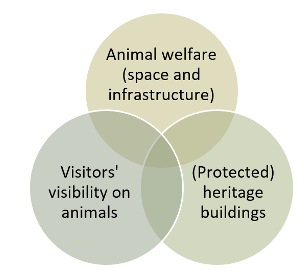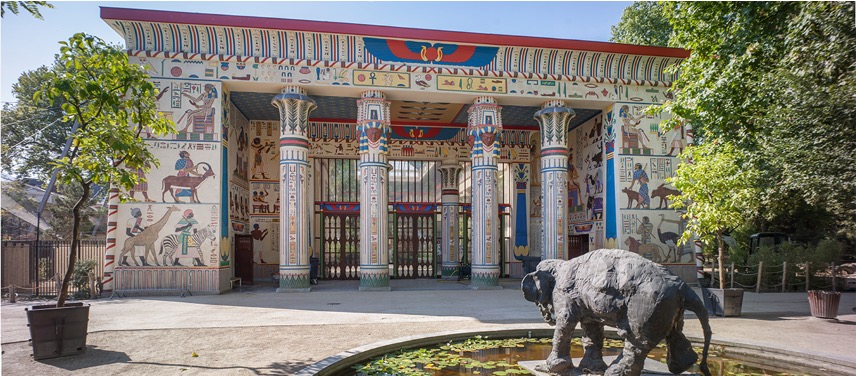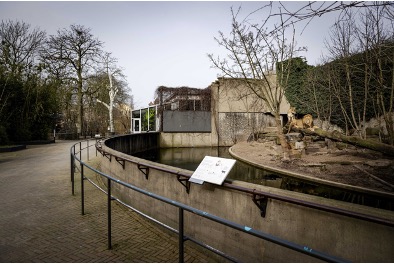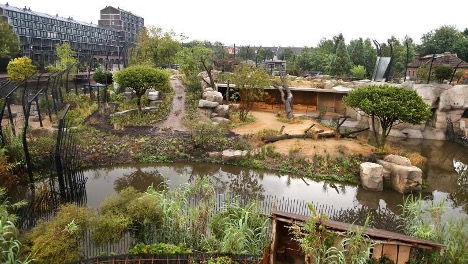By Noor Van Roy
There are various interesting parallels between the histories of Amsterdam (The Netherlands) and Antwerp (Belgium). This blog post will focus on the historic zoos in both cities (first opened during the 19th century) and how both zoos try to find a balance between their modern functions (including promoting animal welfare) and their heritage values.
Urban Zoos: Triarchy of Challenges
The limited size of urban zoos is challenging because one of the key aspects of being a zoo is exhibiting animals to their visitors and they expect to see easily visible and charming animals in naturalistic enclosures (Collins et al., 2023a). Despite the evolution from the initial entertainment function to the more recent conservational and educational functions, zoos stand against their limitations (Edney et al., 2023). In relation to the visitors, the kind of enclosure and the maintenance of it also play a role in the welfare of animals. The setup of the enclosure and proximity to visitors can encourage negative visitor behaviour, like banging on the glass which will cause stress to the animals. Proximity, because of the limited space in the enclosures, forms a catalysator for this undesired behaviour (Collins et al., 2023b).
Think about your own favourite animal in a compacted urban zoo and how much you value their welfare. Most probably, you wish it had more space. The solution seems obvious, meaning to replace historic enclosures and construct larger ones, but this is not simple. The government, zoo direction board, historians and architects became aware of the heritage values of the enclosures during the second half of the 20th century (Gebouwen, 2023). Due to the urban environment and the enlisted protected buildings, the 19th-century city zoos cope with extra challenges besides finance and facing public opinion (Figure 2) (Spooner, 2023).

About this Blog series & the Heriland Blended Intensive Programme
The Blogs in this series (March-July 2024) were written by graduate students and early career professionals who participated in the Heriland Blended Intensive Programme “Heritage and the Planning of Landscapes” in October 2023 in Amsterdam, The Netherlands.
Are you interested in participating in the next iteration of the Heriland Blended Intensive Programme, “Heritage and Landscape Futures”, in Gothenburg, Sweden, in October 2024? Visit: Heriland Intensive Blended Program- Heritage and Landscapes Future
or contact Niels van Manen: n.van.manen@vu.nl
Protected Obstacles?
The Zoo of Antwerp has approximately thirty enlisted protected buildings on the inventory of the Flanders Heritage Agency, including the enclosures like the large African mammals building in eclectic style from 1856 (Figure 3) (Zoo van Antwerpen, 2023). This is the (indoor) residence of the giraffes and elephants. The Flemish Minister of Animals introduced in 2022 new norms about the minimum measurements for enclosures, depending on the animal species. The Zoo of Antwerp responded that they already answer to ‘most of the norms’. Despite the recognition of the hard work they have delivered in the last decade, be reminded of the age of the African mammal enclosure (An Verstuyft, 2022).
Driving one hundred and fifty kilometres to the north, a similar case pops out in the Artis Zoo in Amsterdam, where several buildings are likewise enlisted on the Monuments Register of Cultural Heritage (Rijksmonumentenregister: Artis, 2023). The zoo’s 2030 agenda seeks a clear “before and after”, whereas the enlisted monuments result in an environment where 19th-century Romanticism is still predominant (Experience during my own visit on October 10th 2023; Missie en visie, 2023). The question, therefore, remains if the zoo can convince their visitors that the ‘modern’ zoo practices are working (e.g. conservational, educational, recreational and research goals and objectives) and how these can be managed in a historic zoological garden (Greenwel et al., 2023).

Compromising Past and Future
In the Artis Zoo’s strategic plan, they have been thoughtful in their communication about the 2030 goals. The 19th-century enclosure for the lions is no longer inhabited, but the zoo has kept this empty enclosure, in addition to an information panel on the left, the way it was. On the right, there is a bright-coloured poster which informs the visitors about the relocation of the lions to a bigger enclosure (Figures 4 and 5). In this way, the zoo has respect for their heritage and animal welfare (Based on Experience during my own visit to the Artis Zoo on October 10th 2023). It is not possible to leave all former enclosures empty since this takes up space that can be redesigned for other animals. Nevertheless, it is a step towards their future visions and to say goodbye to the human-animal relation from the past.


The challenge lies within the obstruction of the visitors’ feeling that they are drawn back into the past. It is correct to safeguard the zoos’ past since they are one of the first in Europe, and even the world. Nonetheless, heritage is not only about recognising the past. The enclosures are protected because, at the time of their enlistment, it was regarded as important to keep them for future generations due to their historical, architectural and aesthetic values (Clark, 2019). However, the less anthropogenic approach to heritage includes the nonhuman stakeholders as well in the decision-making (Roudavski & Rutten, 2020). The conservation programmes show already that zoos are working towards the idea of seeing animals as heritage since they have values too (scientific, economic, social and cultural) (Abbott & Tan-Kantor, 2022).
The conservation programs are connected to the zoos’ research departments and both the Zoo of Antwerp and the Artis Zoo in Amsterdam have one. Their research delivers more information on evolution, biodiversity and behaviour of animal species. Zoo animals contribute to knowledge gained in various scientific domains (Hochadel, 2022). The criticism behind the conservation programs, however, states that the animals are marginalised as ‘gene carriers’, despite the fact that such programs could prevent extinction (Mäekivi, 2018). In addition to the scientific value of the zoo animals, there is also an economic value since their existence is inextricably linked to visitors. For example, when three lion cubs were born in 2022, the Zoo of Antwerp announced the news with a press release to attract visitors. In addition, they gave the public the opportunity to choose the names of the three cubs which can lead to a sense of connection (Milio, 2022). This connectivity benefits both humans and animals when improvements to husbandry and management on a species-specific level are made. Since direct contact with green environments enhances the mental state of humans, a zoo environment has a positive influence on visitors when they see healthy animals, performing species-appropriate behaviours. The welfare of animals is connected to the welfare of humans which means that humans have the responsibility to ensure that welfare by providing proper enclosures (Rose & Riley, 2022). A zoo can encourage a changed human-animal relationship by distancing themselves more from the 19th-century zoo. Instead of thinking bigger, they can think smaller. Do we want two unhappy elephants or six happy racoons?

Stepping into the future zoo does not only mean redesigning (energy-neutral) enclosures, it also requires another way of thinking where animals are seen as part of the heritage story and not as a filling of the historic enclosure. The historic enclosure does not necessarily contain the same animals as one hundred years ago. It is important to remember that heritage is dynamic. The zoos can use the spaces to accomplish more to their new functions, namely being an educational institution. A former enclosure can be an educational centre where the zoo can teach people about the history of zoos, conservation programs and the human-animal relationship.
Having protected enclosures does not mean that zoos are stuck in the past. It requires courage and creativity, but the enclosures can lead to the future-minded zoo that they desire to be.

Bibliography
Tony, A. & May, S. (2008). Constructed landscapes in zoos and heritage. International Journal of Heritage Studies 14, no.1. 43–59.
Arnaut, H & Deweer, L.(2018). Leve de zoölogie! Kalmthout: Pelckmans.
“History”. ARTIS. Accessed on October 23, 2023. https://www.artis.nl/en/footer/about-artis/history/.
“Zoos and aquariums in the 21st century”. Wild Welfare. Accessed on November 3, 2023.
https://wildwelfare.org/wp-content/uploads/Zoos-in-21st-Century.pdf.
Abbott, M. & Tan-Kantor, A. (2022). Accounting for zoo animals: it is a jungle out there.”
Australian Accounting Review 32, no, 1. 91-105.
Clark, K. (2019). Playing with the past: Exploring values in heritage practice. Oxford: Berghahn Books.
Collins, C. Barr, Y. Mckeown, S. Scheun, J & Tay, C. (2023a).An international
investigation of the prevalence of negative visitor behaviour in the zoo. Animals 13, no. 16 (2023): 2661.
“Dierentuin Antwerpen”. (2023). Inventory Flanders Heritage Agency. Accessed on November 3, 2023.
https://inventaris.onroerenderfgoed.be/erfgoedobjecten/127085.
“Dierentuin – Egyptische tempel voor grote Afrikaanse diersoorten”. (2023). Flanders Heritage Agency. Accessed on November 3, 2023.
https://inventaris.onroerenderfgoed.be/erfgoedobjecten/7038.
Edney, G. Smart, T. Howat, F. Batchelor, Z. Hughes, C & Moss, A. (2023). Assessing the effect of interpretation design traits on zoo visitor engagement. Zoo Biology 42, no. 4 (2023): 567-576.
“Gebouwen”. Zoo of Antwerp. Accessed on November 3, 2023. https://www.zooantwerpen.be/nl/erfgoed/gebouwen/.
Phillip, G. Riley, L. Lemos de Figueiredo, L. Brereton, J. Mooney, A. & Rose, P. (2023). The societal value of the modern zoo: a commentary on how zoos can positively impact on human populations locally and globally.” Journal of Zoological and Botanical Gardens, no. 4 (2023): 53-69.
Hochadel, O. (2022). Science at the zoo: an introduction.” Centaurus: Journal of the European Society for the History of Science 64, no. 6 (2022): 561–90.
Nelly, M. (2018). “Freedom in captivity: managing zoo animals according to the ‘Five Freedoms’.”
Biosemiotics 11. 7–25.
Luc, M. (2022). Drieling leeuwenwelpen geboren in Zoo Antwerpen. VRT NWS. August 30, 2022. https://www.vrt.be/vrtnws/nl/2022/08/30/drieling-leeuwenwelpen-geboren-in-zoo-antwerpen/.
“Missie en visie”. Artis. Accessed on November 5, 2023. https://www.artis.nl/nl/footer/over-natura-artis-magistra/missie-en-visie/.
“Plattegrond”. Artis. Accessed on November 4, 2023. https://www.artis.nl/nl/bezoek/plan-je-bezoek/plattegrond/.
“Rijksmonumentenregister: Artis”. Cultural Heritage Agency of the Netherlands. Accessed on November 4, 2023. https://monumentenregister.cultureelerfgoed.nl/complexen/518277.
Paul, R. & Riley, L. (2022). Expanding the role of the future zoo: wellbeing should become the fifth aim for modern zoos. Frontiers in Psychology 13. 1–11.
Stanislav, R & Rutten, J. (2020). Towards more-than-human heritage: arboreal habitats as a challenge for heritage preservation.” Built Heritage 4, nr. 4. 1-17.
Spooner, S. Walker, S. Dowell, S & Moss, A. (2023). The value of zoos for species and society: The need for a new model. Biological Conservation 279. 109-925.
Oriol, T. Salas, N & Manteca, X. (2023). Zoo animal welfare assessment: where do we? stand?. Animals 13, no. 12. 19-66.
Verstuyft, A. (2022). Zoogdieren krijgen meer ruimte in Vlaamse dierenparken, Antwerpse parken vol vertrouwen: “Wij halen meeste normen al. VRT NWS. August 16, 2022. https://www.vrt.be/vrtnws/nl/2022/08/16/reacties-dierenparken-op-nieuwe-vlaamse-normen/.
“Zoo van Antwerpen”. Origin: Architecture and Engineering. Accessed on November 4, 2023. https://origin.eu/nl/projecten/zoo-van-antwerpen.
About the author
Noor Van Roy is a postgraduate student in Heritage Studies (major in nature and landscape) at the University of Antwerp. This Blog post is inspired by the fieldwork she conducted while participating in the Heriland Blended Intensive Programme on “Cultural Heritage and the Planning of European Landscapes”, October 2023.
Contact Noor van Roy: noor.vanroy@student.uantwerpen.be

